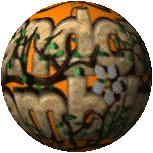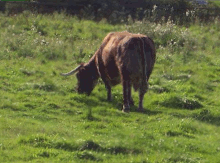To get back to my story ... on this very hot day we travelled to Withybed Green, over the canal bridge that ended up in a cul-de-sac which had a really old public house called 'The Crown Inn.' The Crown Inn ... was magical, it had large green heavy wooden shutters and reminded me of 'The Admiral Benbow' from out of the book called Treasure Island. It had large flower baskets that tumbled with bright flowers and at the back was a large rockery. The rockery was dominated with one flower - it over-flowed with the creeper called 'Creeping Jenny.' The whole area was a mass of thousands upon thousands of bright yellow flowers and I fell in love with this delightful plant there and then.
The owners of the public house very kindly gave my mother a small cutting of the plant which contained a few roots. I have had Creeping Jenny in my garden ever since and find it to be one of those useful plants that you can use in the border, in baskets and tubs ... in fact, anywhere you have either a little gap or you are in need of a trailing plant.
Special note: The Domesday Book came about after the Battle of Hastings in 1066 when King Harold II, (one of England's best Monarch's or Kings) was famously killed on the battle field, taken out by receiving a fatal sword wound, not as many still believe by an arrow in the eye. William wanted to know how much wealth he had acquired and so commissioned the listings of everything in the land that he had conquered and now ruled. This is therefore probably the very first English Census.
Harold's father was the Earl of Wessex, called Godwin and his mother, Gytha was the famous daughter of Ulf the brother-in-law of Denmark's Canute. Although Harold reigned for just 283 days he was a very active monarch. He was a strong and powerful man for at least 13 years. As the Earl of East Anglia he inherited all of his father's lands and soon his title was elevated to Earl of Wessex and Kent and he later formed a very influential position in the life of Edward the Confessor. He went on to conquer and take over the county of Hereford and by the year 1063 he totally crushed the Welsh risings. He was soon to be shipwrecked and held prisoner by Duke William of Normandy in 1064. He skilfully talked his way out by promising that he would help get the Crown for William but as soon as he got back on home territory he claimed that Edward the Confessor had named him as the successor to the thrown. At this time there were several others laying claim to the thrown: Norway's Harold III Hardrada, his brother Tostig, and William of Normandy. Both Tostig and Hardrada were killed by Harold at the Battle of Stamford Bridge on 25 September 1066 (just outside York). Three days after this dreadful battle William invaded Sussex. Harold II and his army had the hard task then of marching 250 miles in nine short days to fight William at Hastings. Harold only narrowly lost the day ... and ended the 600 years of the Anglo Saxon reign of England.
Little is known of Harold's children with the exception that his youngest daughter, Gunhild travelled to Wiltshire to Wilton Abbey and became a Nun. His Eldest daughter called Gytha married the King Waldemar of Novgorod and died in 1125. Harold had at least five sons and two daughters by two wives.
Extra little note: a withy is the fine long stems of the willow that are cut down and re-grow each year. They are usually grown near to rivers, canals, brooks and other water courses. They are used both in thatching and basket weaving. The name Withybed gets its name from the withy.

















































1 comment:
It's beautiful, isn't it? It's very closely related to the Loosestrife, which is a more upright version, of which there is the standard green and a variegated version.
Post a Comment